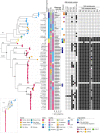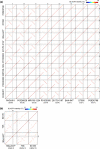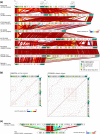Helicobacter cinaedi is a human-adapted lineage in the Helicobacter cinaedi/canicola/'magdeburgensis' complex
- PMID: 35536747
- PMCID: PMC9465070
- DOI: 10.1099/mgen.0.000830
Helicobacter cinaedi is a human-adapted lineage in the Helicobacter cinaedi/canicola/'magdeburgensis' complex
Abstract
Helicobacter cinaedi is an enterohepatic Helicobacter that causes bacteremia and other diseases in humans. While H. cinaedi-like strains are isolated from animals, including dog isolates belonging to a recently proposed H. canicola, little is known about the genetic differences between H. cinaedi and these animal isolates. Here, we sequenced 43 H. cinaedi- or H. canicola-like strains isolated from humans, hamsters, rats and dogs and collected 81 genome sequences of H. cinaedi, H. canicola and other enterohepatic Helicobacter strains from public databases. Genomic comparison of these strains identified four distinct clades (clades I-IV) in H. cinaedi/canicola/'magderbugensis' (HCCM) complex. Among these, clade I corresponds to H. cinaedi sensu stricto and represents a human-adapted lineage in the complex. We identified several genomic features unique to clade I. They include the accumulation of antimicrobial resistance-related mutations that reflects the human association of clade I and the larger genome size and the presence of a CRISPR-Cas system and multiple toxin-antitoxin and restriction-modification systems, both of which indicate the contribution of horizontal gene transfer to the evolution of clade I. In addition, nearly all clade I strains but only a few strains belonging to one minor clade contained a highly variable genomic region encoding a type VI secretion system (T6SS), which could play important roles in gut colonization by killing competitors or inhibiting their growth. We also developed a method to systematically search for H. cinaedi sequences in large metagenome data sets based on the results of genome comparison. Using this method, we successfully identified multiple HCCM complex-containing human faecal metagenome samples and obtained the sequence information covering almost the entire genome of each strain. Importantly, all were clade I strains, supporting our conclusion that H. cinaedi sensu stricto is a human-adapted lineage in the HCCM complex.
Keywords: Helicobacter canicola; Helicobacter cinaedi; Type VI secretion system; enterohepatic Helicobacter; genome comparison; human adaptation; metagenome data search.
Conflict of interest statement
The authors declare that there are no conflicts of interest.
Figures







Similar articles
-
Proposal of Helicobacter canicola sp. nov., previously identified as Helicobacter cinaedi, isolated from canines.Syst Appl Microbiol. 2016 Jul;39(5):307-12. doi: 10.1016/j.syapm.2016.06.004. Epub 2016 Jun 25. Syst Appl Microbiol. 2016. PMID: 27381809
-
Rapid identification and subtyping of Helicobacter cinaedi strains by intact-cell mass spectrometry profiling with the use of matrix-assisted laser desorption ionization-time of flight mass spectrometry.J Clin Microbiol. 2014 Jan;52(1):95-102. doi: 10.1128/JCM.01798-13. Epub 2013 Oct 23. J Clin Microbiol. 2014. PMID: 24153128 Free PMC article.
-
Genotypic and phenotypic characterization of Helicobacter cinaedi and Helicobacter fennelliae strains isolated from humans and animals.J Clin Microbiol. 1995 Nov;33(11):2940-7. doi: 10.1128/jcm.33.11.2940-2947.1995. J Clin Microbiol. 1995. PMID: 8576350 Free PMC article.
-
First case of bacteremia caused by Helicobacter cinaedi in a patient with liver cirrhosis: a case report and literature review.Clin J Gastroenterol. 2015 Oct;8(5):306-17. doi: 10.1007/s12328-015-0600-0. Epub 2015 Sep 5. Clin J Gastroenterol. 2015. PMID: 26342291 Review.
-
Multidrug Efflux Systems in Helicobacter cinaedi.Antibiotics (Basel). 2012 Nov 21;1(1):29-43. doi: 10.3390/antibiotics1010029. Antibiotics (Basel). 2012. PMID: 27029418 Free PMC article. Review.
Cited by
-
Helicobacter cinaedi bacterium association with atherosclerosis and other diseases.Front Microbiol. 2024 Apr 8;15:1371717. doi: 10.3389/fmicb.2024.1371717. eCollection 2024. Front Microbiol. 2024. PMID: 38650874 Free PMC article. Review.
-
Prevalence, diversity and public health implications of Helicobacter species in pet and stray dogs.One Health. 2022 Aug 29;15:100430. doi: 10.1016/j.onehlt.2022.100430. eCollection 2022 Dec. One Health. 2022. PMID: 36277106 Free PMC article.
-
Characterization of HcaA, a novel autotransporter protein in Helicobacter cinaedi, and its role in host cell adhesion.mSphere. 2023 Dec 20;8(6):e0040323. doi: 10.1128/msphere.00403-23. Epub 2023 Nov 27. mSphere. 2023. PMID: 38009997 Free PMC article.
References
Publication types
MeSH terms
Supplementary concepts
LinkOut - more resources
Full Text Sources
Medical

